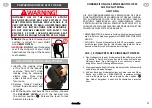
22
1.
Place booster seat firmly against the back of a
forward-facing vehicle seat. The vehicle seat
MUST
be equipped with a 3-point lap-and-shoulder belt.
Booster must be level, stable and not rock side-to-
side (see “Vehicle seating positions”).
2. Place child in the booster seat with child’s back flat
against the back of the booster seat.
3. Adjust headrest height so that the bottom of the
headrest is
EVEN
with the top of the child’s shoulders.
See section “Adjusting headrest”.
4.
Thread shoulder belt portion
of the 3-point lap-and-shoulder
belt system through the
shoulder belt guide ❶
and
ensure that shoulder belt lies
across child’s shoulder and
chest, and
NOT
across child’s
face or neck.
5.
Thread both sides of the lap
belt under BOTH armrests. Thread the lower end of
the shoulder belt under the armrest on the buckle
side
❷
. ENSURE that the belt is snug across the
child’s hips. It is important to ensure that any lap
strap is worn low down, so that the pelvis is firmly
INSTALLATION
WARNING!
!
DUE TO VARYING ANGLES OF VEHICLE SEAT BELT
RETRACTORS, EXCESS SLACK IN THE VEHICLE BELT
SYSTEM MIGHT NOT BE REMOVED AUTOMATICALLY.
Once the lap and shoulder portions of the seat belt
are properly positioned and the buckle is attached,
FEED ANY REMAINING SLACK OF THE SEAT BELT
MANUALLY BACK INTO THE RETRACTOR TO TIGHTEN
THE WHOLE SYSTEM.
❶
❷
EINBAU
!ACHTUNG!
AUFGRUND VERSCHIEDENER WINKEL DER FAHRZEUG
-
GURT-EINZUGMECHANISMEN KANN ES VORKOMMEN, DASS
EIN ÜBERMÄSSIGER DURCHHANG IM FAHRZEUGGURTSYSTEM
NICHT AUTOMATISCH BESEITIGT WIRD. Nachdem die Becken-
und Schulterteile des Sicherheitsgurtes ordnungsgemäß posi
-
tioniert sind und das Gurtschloss eingerastet ist, SCHIEBEN SIE
DEN SICHERHEITSGURT VON HAND IN DEN EINZUGMECHANIS
-
MUS, UM DAS GESAMMTE SYSTEM ZU SPANNEN.
1. Den Kinderautositz fest gegen den Rücken eines in Fahrt
-
richtung orientierten Fahrzeugsitzes platzieren. Der Fahr
-
zeugsitz MUSS mit einem automatischen Dreipunktgurt
(Kombination aus Becken- und Schultergurt) ausgerüstet
sein. Der Kinderautositz muss waagerecht und stabil sein,
und darf seitlich nicht kippen (siehe „Sitzpositionen im
KFZ“).
2. Das Kind in den Kinderautositz setzen, wobei der Rücken
des Kindes eng an der Rückenlehne des Kinderautositzes
anliegen muss.
3. Die Höhe der Kopfstütze einstellen, so dass die Unterkante
der Kopfstütze auf Höhe der Schultern des Kindes ist. Siehe
Abschnitt „Einstellung der Kopfstütze“.
4. Den Schultergurtteil des Dreipunktgurtes durch die Schul
-
tergurtführung ❶ führen und gewährleisten, dass der
Schultergurt über die Schulter und den Brustkorb des Kin
-
des geführt ist, NICHT aber über das Gesicht oder den Hals
des Kindes.
5. Beide Seiten des Beckengurtes unter BEIDEN Armlehnen
durchführen. Das untere Ende des Schultergurtes auf der
Seite mit dem Gurtschloss unter der Armlehne durchführen
❷. GEWÄHRLEISTEN Sie, dass der Gurt eng an den Hüften
des Kindes anliegt. Achten Sie darauf, dass der Beckengurt
möglichst weit unten anliegt, damit das Becken fest veran
-
kert ist und die Oberschenkel gerade noch berührt werden,
und dass er NICHT auf dem Bauch des Kindes aufliegt.















































